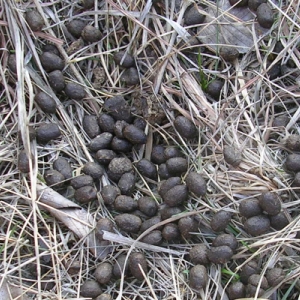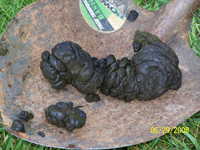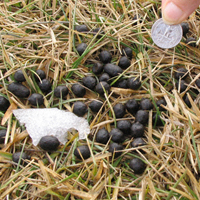Be careful! Droppings can carry pathogens that cause diseases in humans. Wear gloves and wash thoroughly after working with or near droppings.
What shape are the droppings?
| Tubular | Pelleted | Globular |
 |  |  |
If droppings are smaller than those of a dog, click here.
Tubular
| Black Bear (Ursus americanus): The shovel in the photo gives an idea of the size of the droppings. Color will vary, depending on what the bear has been eating. |  |
| Coyote (Canis latrans): Droppings can be several inches long and full of animal hair, especially in winter when fruit is not available. Droppings will be dark due to blood of the prey. They will often be found at cross roads and along trails, as coyotes use droppings to mark their territory. |  |
| White-tailed Deer (Odocoileus virginianus): Deer can have tubular or pelleted scat. The pellets can usually be seen even in tubular deer scat. |  |
| Raccoon (Procyon lotor): Droppings are 2 to 3 inches long and 1/2 inch wide. You often can identify what a raccoon recently has been eating. Corn kernels or fruit may be visible, for example. Droppings frequently are found in piles, called latrines, on roofs, in attics, in sandboxes, or open areas. Raccoons defecate in the same location. Caution!! Raccoon feces may contain a dangerous roundworm. Learn more about Raccoon roundworm. |  |
| Toad (Bufo sp.): Droppings can be found in the same area morning after morning, often near flood lights as toads are drawn to insects attracted to the night lights. You may see exoskeletons of insects in the scat. |  |
| Shrews (Family Soricidae): Shrew droppings are 1/16 inch in diameter and almost a 1/4 inch in length. They are frequently curled and in piles. The odor is quite distinctive. |  |
Pelleted Droppings and/or Smaller than Dog Droppings
| Bats (Order Chiroptera) The image shows a close-up of bat droppings with a penny for scale. The white speckles in this fresh guano are the remains of undigested insect wings. Bats often defecate when leaving the building they live in. Sometimes you can see droppings caught in spider webs, too. Bat droppings tend to be in piles in the attic below where they roost during the day. WARNING: Don't enter attics without wearing proper protection, which includes but is not limited to, a HEPA filter mask, sturdy gloves, long pants, and good lighting. Make sure filter masks are properly fitted and that you are healthy enough to breathe with a mask. |  |
| Caterpillars (Family Limacodidae) Scat from caterpillars tends to be squarish and cubed, but can be easily confused with bat droppings. Caterpillar droppings are typically found underneath trees. |  |
| Cockroaches (Periplaneta americana) In the photo, the 2 small black flecks to the right of the penny are cockroach droppings. They can look like pepper sprinkled on the floor. |  |
| White-tailed Deer (Odocoileus virginianus) White-tailed deer droppings are found in piles, much like those of llamas and elk. |  |
| Elk (Cervus elaphus nelsoni) You'll see elk droppings in piles or clusters, the same as for deer and llamas. Elk droppings are larger than deer droppings. |  |
| House Mice (Mus musculus) Mouse scat tends to be black (hard when dry), pointed on one end, and about 1/4 inch in length. You'll find them in scattered patterns in high-traffic areas. |  |
| Flying Squirrels (Family Sciuridae) Droppings of flying squirrels appear moist. This photo was taken of the area directly below the attic vent that the flying squirrels were using to exit and enter the building. Never enter an attic without proper protection. Flying squirrel excrement has been known to contain typhus. |  |
| Rabbits (Family Lagomorph) Scat is usually found where they are feeding. These brown droppings are due to the excessive amount of bark consumed, a typical occurrence during a snowy winter. |  |
Globular
Globular droppings are difficult to identify because the scat lacks distinctive characteristics of formed scat. That means that the amount and location are even more important clues for identifying the source of the scat.
| Black Bear (Ursus americanus) Scat of black bear typically can be identified by location (i.e. do black bears reside in your state?) and by size, as droppings tend to be large (human-sized). |  |
| White-tailed Deer (Odocoileus virginianus) During the summer and periods where deer can obtain a high-fiber diet, the pellets will frequently clump. Photo courtesy of Roger Barcus of MN. |  |